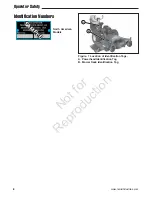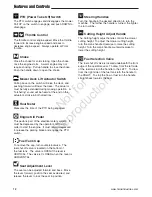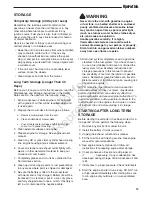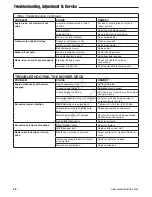
18
www.ferrisindustries.com
Operation
Proper Mulching
Mulching consists of a mower deck which cuts and
recuts clippings into tiny particles and which then
blows them down INTO the lawn. These tiny particles
decompose rapidly into by-products your lawn can
use. UNDER PROPER CONDITIONS, your mulching
mower will virtually eliminate noticeable clippings on
the lawn surface.
NOTE: When mulching under heavy cutting
conditions, a rumbling sound may be present and is
normal.
MULCHING REQUIRES EXCELLENT MOWING
CONDITIONS
Mulching mowers cannot function properly if the grass
is wet, or if the grass is simply to high to cut. Even
more than normal mowing, mulching requires that the
grass be dry and the the appropriate amount is cut.
Do not use the mower as a mulching mower during
the first two or three mowings in the spring. The
long grass blades, quick growth, and often wetter
conditions are more suitable for broadcasting (side-
discharging) or grass bagging operation.
ENGINE SPEED & GROUND SPEED FOR
BROADCASTING
Use full engine throttle matched with a slow ground
speed so that clippings will be finely cut. Ground
speed while mulching should be HALF of the
speed that would be used when broadcasting (side
discharging) under similar conditions. Since mulching
requires more horsepower than broadcasting, using
a slower ground speed is vitally important for proper
mulching operation.
HOW MUCH GRASS TO MULCH
The best mulching action typically results from cutting
only the top 1/2 inch to 3/4 inch of grass blade. This
provides short clippings which decompose properly
(much more quickly than longer clippings). The ideal
cutting height will vary with climate, time of year,
and quality of your lawn. We recommend that you
experiment with both the cutting height and ground
speed until you achieve the best cut. Start with a high
cutting height and using progressively lower settings
until you find a cutting height that is matched to your
mowing conditions and preferences.
Mulching Action
PUSHING THE RIDER BY HAND
1. Disengage the PTO, engage the parking brake,
turn the ignition OFF and remove the key.
2. To disengage the pump (free-wheel position), turn
the hydraulic release valve (A, Figure 5) located
on the hydraulic pump COUNTER-CLOCKWISE a
maximum of 2 full turns.
3. Disengage the parking brake.
The tractor can now be pushed by hand.
4. After moving the tractor, re-engage the pumps
(drive position) by turning the release valves
CLOCKWISE and tighten to 80-120 in. lbs. of
torque.
DO NOT TOW RIDER
Towing the unit will cause hydraulic pump
and wheel motor damage. Do not use
another vehicle to push or pull this unit.
Figure 5. Hydraulic System By-Pass
A. Hydraulic Release Valve
A
Not
for
Reproduction
















































